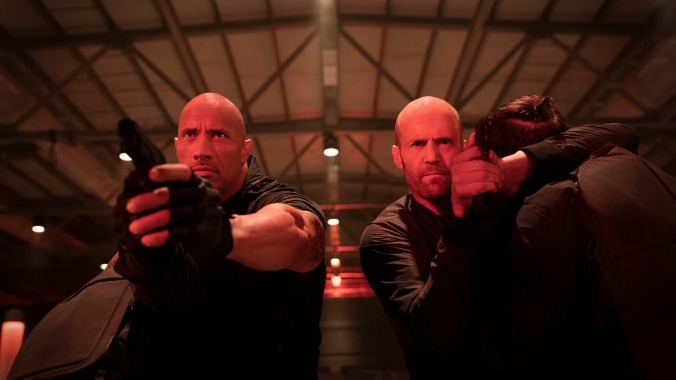Yes, Fast & Furious Presents: Hobbs & Shaw is extremely silly. For its first 30 or so minutes, it also manages to be fun. Pushing the series’ escalating cheesiness even further into James Bond and sci-fi territory, it opens with Brixton Lore (Idris Elba), an evil ex-spy who’s more machine than man, attempting to hijack a sample of the aforementioned virus (codenamed “Snowflake”) in London on behalf of a shadowy organization called Eteon. Instead, it ends up in the hands—or rather, the bloodstream—of Hattie Shaw (Vanessa Kirby), an MI6 agent who also happens to be the estranged younger sister of the ex-assassin Deckard Shaw (Jason Statham). Framed by Brixton, Hattie goes on the run. Before long, the CIA is on the case, recruiting Shaw and his frenemy, the colossal Diplomatic Security Service agent Luke Hobbs (Dwayne Johnson), to track her down.
Butting bald heads from the moment they first come face to face in what appears to be the CIA’s most conspicuous and luxurious black site, Johnson and Statham lean hard into their established alpha-male personas as director David Leitch riffs on the big-and-little contrast, putting them side-by-side in split screens and parallel corridors, and playing them off of Elba’s relished villainy. But while Leitch, who co-directed John Wick before striking out on his own with Atomic Blonde, has proven before that he’s capable of helming a stylish action sequence, his contributions to Hobbs & Shaw mostly amount to designer lighting, visual symmetry, and a more irreverent approach to the script. (This includes a couple of gratuitously extended, improv-y uncredited movie-star cameos.) As in his last film, Deadpool 2, the staging of loud, destructive, effects-laden set pieces seems to elude the director’s grasp—and, unfortunately, that’s what Fast & Furious movies are all about.
The unwieldy ensemble casts of the later Fast & Furious movies were in many ways their secret weapon, allowing the films to keep switching points of view amid the increasingly ludicrous proceedings. But in Hobbs & Shaw, Vin Diesel’s Dominic Toretto and the rest of his crew are nowhere in sight, leaving the movie with fewer options. The souped-up, eye-searing Mitsubishis, Nissans, and Hondas that were once the series’ stock in trade having finally given way to heavy-duty military-industrial tech, and there are only so many times a scene can cut to Johnson pretending to drive a truck before everything starts to descend into weightless (and, by series standards, largely uninspired) mayhem. Leitch at least knows how to borrow from the best: Shamelessly cribbing from Mad Max: Fury Road in an attack-helicopter-versus-hot-rod chase, he even goes so far as to copy George Miller’s frenzied dolly-ins and close-ups. But the results are less than stimulating.
Which leaves that other staple of the series: scenes of characters looking into the sunset while they talk about the importance of “family.” At this point, this theme is basically a franchise obligation, and Hobbs & Shaw serves up variations for both of its heroes, with single-dad Hobbs going back to Samoa to reconnect with his family, and Shaw trying to reconnect with his sister at the behest of their incarcerated mom (Helen Mirren), a career criminal who treats prison like a retirement community. (The third Shaw sibling, Luke Evans’ Owen Shaw, goes unmentioned, but then these movies aren’t really known for their consistency.) The sincere dopiness—which climaxes with Hobbs declaring, “Brother, you may believe in machines, but we believe in people”—never sits well with the wiseass, self-mocking tone that Leitch adopts in the early, more energetic stretches of the film. The difference between being too smart for one’s own good and not being smart enough can be perilously thin.













![HBO teases new Euphoria, Larry David, and much more in 2026 sizzle reel [Updated]](https://img.pastemagazine.com/wp-content/avuploads/2025/12/12100344/MixCollage-12-Dec-2025-09-56-AM-9137.jpg)




























